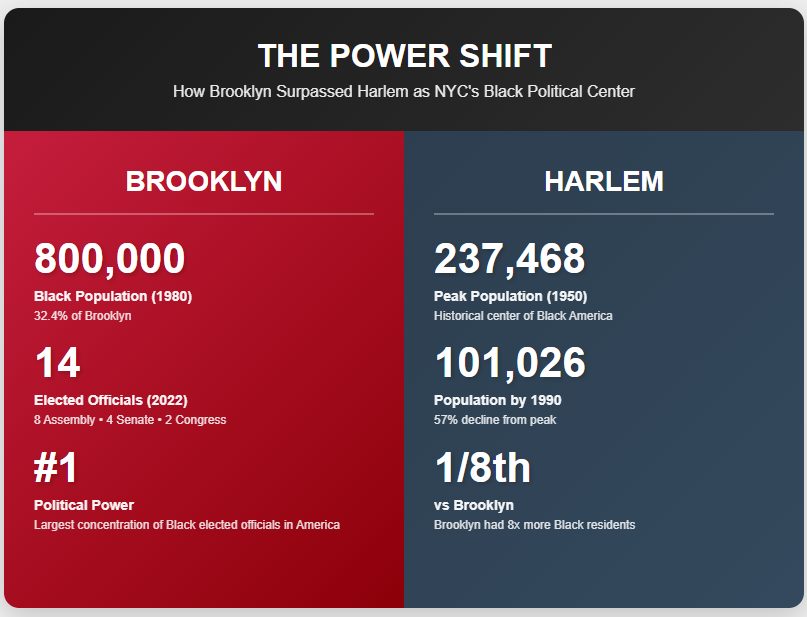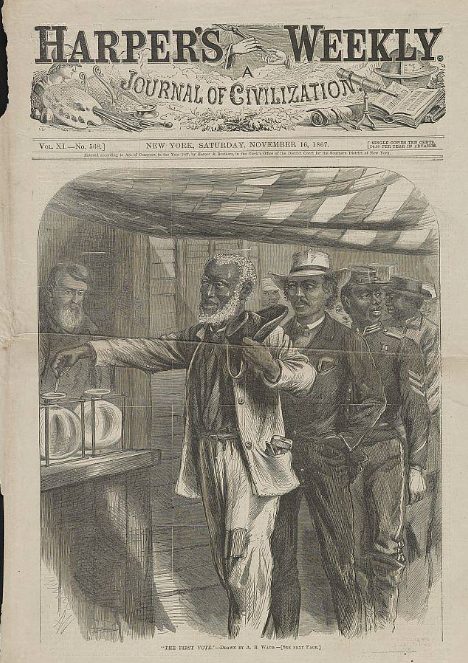The majority of these districts—24 in total—swung in the Democratic direction over that period; these appear in yellow or green in the map above (and in a larger version here), which shows every district as the same size so that dense urban districts aren’t obscured and rural districts aren’t overemphasized. (You can find a traditional map further below.) For the most part, these districts are in educated and affluent suburbs, consistent with the increased move by college-educated voters into the Democratic camp over the last decade.
However, there are also a number of districts that swung in the Republican direction, which show up as orange and pink in the map above. These tend to be districts with lower levels of college education, mostly found in the Midwest or Northeast, representing the flip-side of increased educational polarization. We’ll look in more detail at each of these categories below.
Why is this data important? For one thing, it helps us think more clearly about the next few presidential elections, assuming that current trajectories continue. For instance, we can see why Georgia—with two districts shaded in yellow, the 6th and 7th—tipped narrowly into the blue column last year and will probably continue to evolve in that direction, while Iowa—painted mostly orange—looks to be moving decisively away from Democrats.
Furthermore, there isn’t much ticket-splitting any more. With fewer voters likely to vote for one party for president and the other party for their local representative, the presidential vote by congressional district tends to closely mirror House results. The few split-ticket districts tend to be ones where the House vote hasn’t quite caught up with the presidential trajectory yet.
Below we’ll examine each of the main groups of districts that have switched sides over the past decade. For each section header, we’re also including the number of seats held by Democrats and Republicans in the House.
Romney/Trump/Biden (12 districts: 10 D, 2 R)
There are 12 districts that voted for Mitt Romney in 2012, Donald Trump in 2016, and Joe Biden in 2020. As noted above, these are largely highly educated suburbs. In Georgia’s 6th, for example, over 60% of adults have a bachelor’s degree or higher; this is one of highest rates in the entire nation and, until 2018 (when Democrat Lucy McBath picked up this seat in Atlanta’s northern suburbs), it was the best-educated district represented in the House by a Republican. New Jersey’s 11th and Michigan’s 11th, which are also in this group, fall into a similar bucket, for instance.
There’s one district out of this dozen that doesn’t really fit this pattern, though: Arizona’s 1st, which is largely rural and has a below-median level of college education. However, it’s a diverse district with significant Native American and Latino populations. Following narrow losses here by Barack Obama and Hillary Clinton, the Biden campaign’s full-court press on Arizona helped push Native and Latino turnout higher, and along with college-age voters in Flagstaff, that was enough for a narrow Democratic win here.
Not coincidentally, nine of these 12 districts also saw House pickups in 2018 (including a special election that spring for the predecessor of the 17th District in Pennsylvania). Arizona’s 1st, which has been Democratic-held at the House level all decade is one exception; the other two are Nebraska’s 2nd in Omaha and Texas’ 24th district in the Dallas and Fort Worth suburbs, which Democrats targeted heavily in 2020 and presumably will again in the near future unless Republicans dramatically reshape them in redistricting.
Romney/Clinton/Biden (12 Districts: 9 D, 3 R)
There are also 12 districts that voted for Romney in 2012 and Biden in 2020 but switched sides a cycle earlier in backing Hillary Clinton in 2016. These are also, for the most part, well-educated and affluent suburbs. For example, Virginia’s 10th and California’s 45th were the second- and third-most-college-educated districts that had Republican representatives up until 2018. (Like Georgia’s 6th, they’re also now represented by Democrats.)
If there’s a difference from the previous bucket, these districts tend to be somewhat more diverse, usually with fairly large Latino populations. In fact, five of the 12 districts in this bucket are in California, along with one more in Arizona (the 2nd) and two in Texas (the 7th and 32nd). In other words, they’re a bit further along than the previous dozen in their evolution in the blue direction. In fact, all 12 of these districts were Democratic pickups in the 2018 blue wave!
However, there’s one wrinkle here—three of these districts bounced back in the GOP direction in 2020 at the House level, all in southern California: the 25th, 39th, and 48th. These results seem very House-specific, though, perhaps owing more to candidate quality or local issues, as the Democratic presidential margin continued to improve from 2016 to 2020 in the 25th and 39th. Even in the 48th, the overall trajectory is still clear: Romney won in this district by 12 points, while Clinton won it by 1.7 and Biden by 1.5. House Republicans in these three districts may not want to get too comfortable for the long term.
As an aside, there are also a number of other districts outside of this group that saw a profound swing toward Democrats but that started from a low-enough baseline that they didn’t move all the way into the blue column and thus don’t show up on the map. One major case in point is Texas’ 3rd, also in the Dallas suburbs, which went from a 30-point Romney landslide in 2012 to a 1-point Trump win in 2020! Several other Texas districts, along with Arizona’s 6th, had swings almost that big as well but remained in the Republican column—at least for now.
Obama/Trump/Trump (16 Districts: 6 D, 10 R)
The unfortunate flipside of increased polarization along educational lines is reflected in these 16 districts with mostly below-median college education levels, where Obama won in 2012 but Trump prevailed twice. Three of Iowa’s four districts are in this bucket, along with five more Midwestern seats, including Wisconsin’s 3rd, which was instrumental in that state’s flip to Trump in 2016.
The remaining eight districts are in the Northeast. That includes rural Maine’s 2nd District and Pennsylvania’s 8th District in the Scranton area, where Joe Biden’s favorite son status wasn’t quite enough to overcome the local demographic trend.
However, there are some more traditionally suburban districts in this category, too: New Jersey’s 3rd, located partly in Philadelphia’s suburbs but also largely on the Jersey Shore; New York’s 1st, on the eastern end of Long Island; and New York’s 11th, centered on Staten Island in New York City. These three districts in fact have above-median levels of college education but still retain something of a blue-collar vibe.
In contrast with the two dozen Romney-to-Biden districts, of which Republicans hold five, Democrats represent a greater proportion these Obama-to-Trump districts, six of 16 in total—though that’s still diminished from where we were at the start of the decade. (There’s also one Obama-Clinton-Trump district now held by the GOP that we’ll get to below.)
Again, it may come down to candidate quality, where the survivors are a mix of well-established long-timers, such as Ron Kind in Wisconsin’s 3rd and Matt Cartwright in Pennsylvania’s 8th, and 2018 winners who are good at speaking the local language, such as Jared Golden in Maine’s 2nd and Cindy Axne in Iowa’s 3rd. In fact, you could view the Democrats’ narrow overall edge in the House as being dependent on the remaining Democrats who’ve been able to hold on in this bucket of districts.
One thing you might be wondering is why these Northern districts only started to flip in the last few cycles as opposed to their counterparts in the South that have similarly high levels of white residents and low levels of college graduates, which have been solidly Republican for a number of decades now. A lot of it comes down to a different dimension: religion.
Indeed, those Southern districts are home to far more evangelical Christians, meaning so-called “culture war” issues had an earlier galvanizing effect during the 1980s and 1990s. It took longer for culture wars to supplant economic issues in salience in the North, where most of the voters instead are Catholic or mainline Protestant (or, in the case of Maine’s 2nd, disproportionately non-religious).
As something of a mirror image to the many near-miss Texas districts, there were also a number of districts that saw a big cumulative swing in the Republican direction over the last decade, but started from a blue-enough baseline that they still had narrow Biden wins in 2020, along with more comfortable wins for House Democrats. These are largely Midwestern blue-collar districts such as Michigan’s 5th in Flint, Ohio’s 9th in Toledo and Cleveland, and Ohio’s 13th in Youngstown and Akron.
Obama/Trump/Biden (5 Districts: 5 D, 0 R)
There are only five districts that went with the Electoral College winner each time, and it’s kind of an odd grab-bag: Minnesota’s 2nd in Minneapolis’ suburbs, Nevada’s 3rd in Las Vegas’ suburbs, New Hampshire’s 1st in the state’s southeastern corner, and New York’s 18th and 19th Districts, which are located in either the northernmost parts of the New York City metro area—or the southernmost parts of Upstate New York, depending on where you draw that line.
These are all districts that are relatively close to the national median in terms of education. More importantly, these are simply districts that were very closely divided in each of the last three elections and just don’t float around much from the national average.
New Hampshire’s 1st, which flipped back and forth between the two parties five times in the six elections from 2006 to 2016, may be the best example of a perpetual swing district. Nevada’s 3rd, meanwhile, may be the most reliably centered district at the presidential level. Obama won it by 0.8 points in 2012, then Trump won it by 1 point in 2016, and then Biden won it by only 0.2 points last year!
One encouraging data point about these five districts, though, is that they’re all currently represented by Democrats in the House. In fact, they were mostly comfortable House wins, with Angie Craig in Minnesota’s 2nd district being the closest call, in part thanks to the third-party effect from a candidate from the Legal Marijuana Party (who, in fact, happened to be dead but remained on the ballot).
Outliers (2 Districts: 0 D, 2 R)
There are two other districts that reside in their own categories: Florida’s 26th District in Miami’s suburbs, which went Obama/Clinton/Trump, and Texas’ 23rd District, a suburban/rural mix of a district following the southern border with Mexico for hundreds of miles, which went Romney/Clinton/Trump. There’s an important common thread between them, though, as both are home to Latino-majority populations and have seen close races throughout the last decade.
The general Latino trend toward Trump in 2020—which may be better described as Biden not overperforming among Latinos as much as Clinton did rather than a purely pro-Trump phenomenon—was particularly pronounced in South Florida and South Texas. That trend was enough to pull both of these swingy districts back over the line into the red column.
Unfortunately for Democrats, the trend extended downballot, and Republicans won both the House races in these districts. 2018 victor Debbie Mucarsel-Powell narrowly lost re-election in Florida, while Gina Ortiz Jones, who’d been widely expected to pick up the 23rd in Texas after Republican incumbent Will Hurd’s retirement also came up just short.
The Districts That Didn’t Budge
At the outset of this piece, we noted that 388 districts voted for the same party for president in each of the last three elections. However, there are a handful of seats that are represented by the opposite party at the House level even in this category. Of the 195 districts that supported Obama, Clinton, and Biden, four are held by Republicans: California’s 21st, Florida’s 27th, New York’s 24th, and Pennsylvania’s 1st.
At first glance, these districts don’t have much to do with each other beyond the fact that they’re typically close swing seats. The California and Florida districts have Latino majorities, although California’s 21st is very agricultural with low levels of education, while Florida’s 27th, in Miami, is cosmopolitan and highly-educated. The two northeastern districts (New York’s 24th in Syracuse and Pennsylvania’s 1st in Philadelphia’s suburbs), meanwhile, are middle-class suburban areas notable for being heavily Catholic.
Once more, the biggest factor—even though it’s increasingly of lesser importance in our polarized era—is the quality of the incumbents. The northeastern districts are home to two of the last remnants of the moderate northeastern Republican tradition, John Katko in New York and Brian Fitzpatrick in Pennsylvania. The California and Florida districts were both represented by non-Latino Democrats who narrowly picked up those seats in 2018 (TJ Cox and Donna Shalala, respectively) and were unable to overcome the pro-Trump Latino trends in 2020.
There’s also one district among the 193 that went for Romney and backed Trump both times that’s managed to elect a Democrat, Michigan’s 8th. If you’re wondering what the special sauce in this particular district is, it’s a combination of a district that only narrowly went Republican in all three elections (the presence of Lansing, with college students and state employees, counterbalances the rural parts of this district), and a talented representative in Elissa Slotkin, who seems to embody the old-fashioned but still effective combination of smart campaigning and attentiveness to her constituents.
More Data
Finally, let’s talk about further data you can check out! If you don’t like cartograms (which trade geographic accuracy for better representation of density), we also have a map with a standard projection (see here for a larger version) of the same information. Naturally, this map makes the country look much redder than it actually is thanks to the concentration of Democratic strength in the cities and suburbs. In addition, all of this information, including the specific percentages each candidate earned in each of the last three elections, is available in spreadsheet format here.
You might also be wondering about what happened in Obama’s 2008 election, and how that compares. We’ve calculated the results under the current district boundaries for the 2008 election as well, but we didn’t include that in the map because it would double the number of permutations, meaning the many additional colors required would be to chaotic to interpret.
However, you can see the 2008 election numbers as well on this spreadsheet. In addition, we have maps depicting the results by district for each of the 2008, 2012, 2016, and 2020 presidential elections. My colleague Stephen Wolf also wrote in greater detail in 2018 about the 2008-to-2016 trend at the congressional district level.













